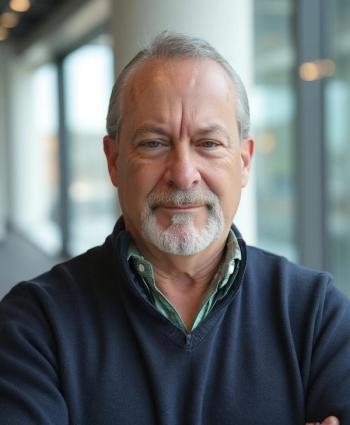
Regulators focus on reducing physician EHR burden
National Coordinator Don Rucker on why figuring out system problems is similar to diagnosing a patient’s illness
Solving the long-standing puzzle that is lack of interoperability among electronic health records (EHRs) requires computer system savvy as well as knowledge about improving patient care.
The Office of the National Coordinator for Health Information Technology (ONC) may, then, have the right person to guide it in Don Rucker, MD. Rucker, named to the post in March 2017, is skilled in informatics, board certified in emergency and internal medicine and built an early version of an EHR nearly two decades ago.
HOT TOPIC:
Medical Economics spoke with Rucker at the ONC’s recent annual conference in Washington, D.C. about his vision for healthcare IT and how to address his peers’ frustrations with EHRs, among other topics.
Medical Economics: Physicians remain frustrated with EHRs. What is the ONC doing to enable these systems to truly improve patient care?
Don Rucker, MD: I think ONC has a couple of roles in reducing what we call provider burden, specifically physician burden.
There are legal things. The most recent is the 21st Century Cures Act passed in December 2016, which has the requirement that CMS [the Centers for Medicare & Medicaid Services] and ONC work together to actually really start this process by defining what the burdens are. Truth be known, we are well on our way to working on not just defining it, but also reducing it. It’s complex.
I think when ONC looks at it, there’s a couple of things going on when we talk about EHR burden. It is similar to a patient with four chronic illnesses. That’s the way I look at EHR provider burden. It’s the patient with bad hypertension, who has had a stroke, had diabetes, has heart failure and is on steroids-that’s my view of what this is.
MORE:
So you have to think about what can I do for each of these things? It is very, very clinical. The burden is multi factorial and you need to diagnose each of the components.
When you look at [EHR burden] clinically, another “disease” is that some things come down to “software is hard to do, so can we facilitate doing that?” The providers who work with the software companies don’t often understand what they are telling software developers.
We, as docs, think of ourselves as logic machines. So the software developers have developed software to enable logic, which of course, means lots of clicks and other things. But the human brain is a pattern recognizer. So instead of giving us broad, easy targets so we can see what’s on a computer screen the minute we walk back into the exam room, we can’t even regain the context from our interruption without reading a bunch of stuff.
Software developers often build tools to represent state-of-the art in software, but that’s for people typically sitting at a desk and aren’t interrupted every second.
TRENDING:
I’m an emergency medicine doctor and done hospitalist work and you get interrupted constantly. The average office practice … gets at least 200 inbound phone calls a day, so we live in an interrupted world. Software developers live in a different world, so we need to start thinking of tools that are healthcare specific, which is not what we’ve had.
That’s one of the diseases, if you will, in this chronic disease model of the EHR.
Federal policies are also a complex contributing cause. We have a lot of policies. CMS and [administrator] Seema Verma are working extremely hard on identifying each of these things and rethinking them, so this administration is really focused on this.
Q: Is the ONC concerned about doctors retiring or leaving medicine rather than switch from paper charts to EHRs? What would you say to try and get such a doctor to change his/her mind?
Rucker: One of the things I can say, in terms of control of your destiny and choice, is … doctors don’t spend enough time working with vendors. I think there is going to be some interesting data coming out that the installation of this software makes a huge difference in usability. There is some anecdotal evidence now that there are large differences in how you implement an EHR.
For example, what do you put in the menu? So in the menu, let’s say there is something for referrals. I’ve worked in places that there was no way to easily identify the local docs in the system in that menu. They purchased a database from somewhere so it had docs from other states, 100 miles away. If I have to go through a list of people I’ve never ever and never will refer to every time I want to refer someone to the local ENT or OB/GYN, that’s frustrating.
POPULAR ONLINE:
Before you retire, try to look at the parts of this you can control. Ultimately, those comments reflect that we-collectively-have put burdens in the hours per day on many providers with this family of technologies and policies and it doesn’t work. It’s not a value-add.
Patients pay for this. It is always framed as a provider burden. But this is as much a burden on patients. If I’m a patient, whether it is embedded in the overhead or not, I’m paying for this.
Q: What gains can you say ONC has made to prevent EHR data blocking?
Rucker: There are a couple things in play here. First, with certified EHRs, the vendors who certify have to say they are not information blocking. Providers, as a condition of participation [in performance programs], are not allowed to information block either. That’s the law. We are writing language to define what those things mean and that’s in the regulatory process at the moment.
The reason Congress passed the Cures Act isn’t simply because provider “A” can’t get provider “B’s” records. It’s not that I can’t get the op note from somebody in my primary care practice or the discharge summary. The root reason, I think, is when you read the language, patients are not empowered with their data. They have to go begging for their data. We hear example after example of this. How can patients get their data? I think that’s very important.
FURTHER READING:
Ultimately, I think this reflects that we need to have more institutional accountability. This is really about the cost of healthcare-this interoperability argument. This is ultimately about the cost of care and what am I getting when I pay for care and can I shop elsewhere? These are obviously heated discussions, because they are very commercial discussions. But part of this is the institutional accountability.
Q: As a physician, do you think it is appropriate to ask doctors to submit data for quality metrics when interoperability doesn’t exist to aid that process? What is ONC doing to address this issue?
Rucker: The mechanisms to measure quality are imperfect-that’s probably an understatement. At best, the processes to report the data are less than perfect. I think they are very problematic, very expensive. Again, when these expenses come, ultimately patients pay for this. It’s a total nuisance to the docs and ultimately this is somehow paid for by doctors who are spending more hours away from their families.
This is an area where we have to rethink. I think folks have to realize the political dynamic here because so much money is spent in healthcare; it is so murky what is obtained.
IN CASE YOU MISSED IT:
Congress is looking for value. How do you measure value? I think as clinicians we all have an idea what we do that adds value, but how do we measure it? I think the anxiety [physicians] are seeing is because we don’t have good ways of really measuring that and certainly the ways we have are so expensive that it becomes unclear whether there is even a net positive effect.
Q: How are ONC and CMS working on this?
Rucker: The first order of business is to analyze what the tasks are. There are a whole bunch of components to these tasks. There are different regulations, there are different effects, there are different documentation requirements. So the first order of business is to understand how these play out.
It’s worth noting the different ways, different places and different audiences here. There are rules that affect Medicaid, rules that affect Medicare (most of the private practice docs). There are rules that affect folks who are in networks, ACOs, for Medicare Advantage. So the first order of business is to play those out.
Q: You said in a 2017 blog post that you envision care driven by “multiple electronic data streams,” comprised of personal medical history and population/public health efforts. How can ONC help make that a reality?
Rucker: When you ask, “how are we going to practice medicine in the future?” It’s a technology world. When I started practicing, head CT scanners were only in a couple of places. MRI was unheard of. It was a very different world. So I’ve seen a lot of things.
Computer data is everywhere and in the computer world, they call it a mash-up: different data streams, natural language processing of notes, patient-entered data, all the imaging technologies, the gene sequencing, proteomics-all of these things are coming together.
MORE:
Our world is rapidly morphing. It will be a computer software-driven world in part, but ultimately, it is still a very human world and every patient is ultimately unique. All these things will come together. I see IT as one of those tools. A lot of what ONC does is say “let’s try to lower the transaction costs of putting the things together and let the physicians, the entrepreneurs and scientists figure out how to do it.”
Our job is to set the width of the railroad tracks.
Newsletter
Stay informed and empowered with Medical Economics enewsletter, delivering expert insights, financial strategies, practice management tips and technology trends — tailored for today’s physicians.








